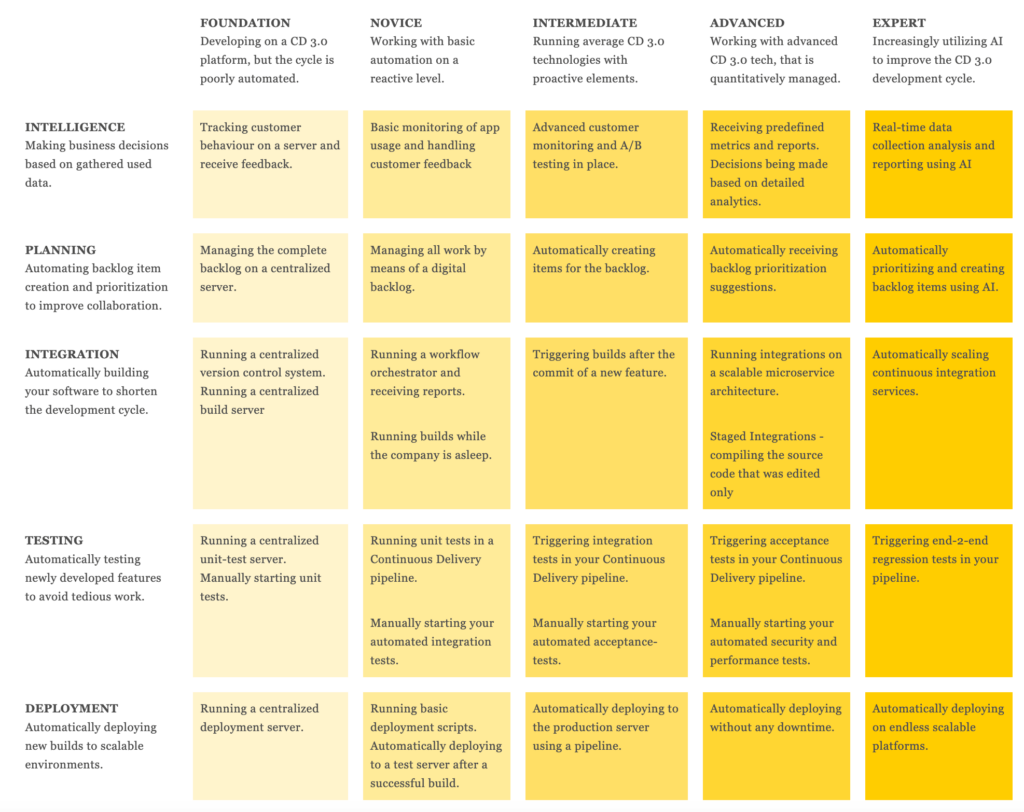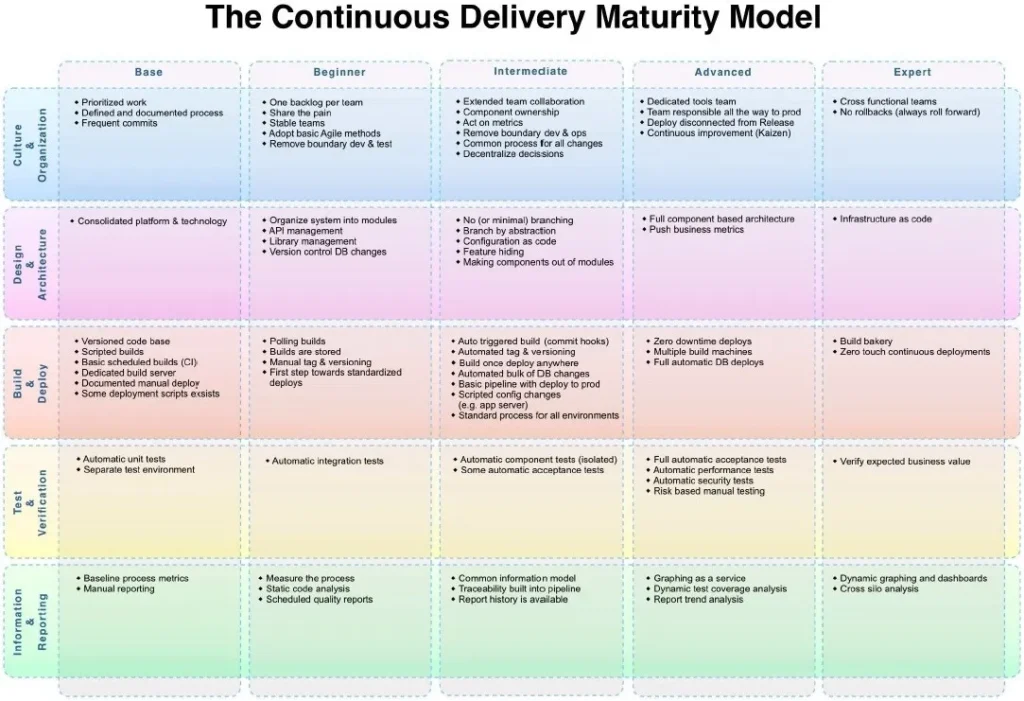What Is a Continuous Delivery Maturity Model (CDMM)?
A Continuous Delivery Maturity Model (CDMM) is a framework for assessing an organization’s maturity in implementing continuous delivery practices. It is designed to guide organizations in their efforts to improve their software development process and ultimately achieve continuous delivery.
While there is no single standard for CDMM, most models proposed in the industry consist of five levels, with Level 1 being the lowest level of maturity and Level 5 being the highest. Each level represents a set of capabilities that an organization must have in order to achieve that level of maturity.
The CDMM can be used to identify areas for improvement and guide an organization’s efforts to implement continuous delivery practices. It can also be used to benchmark the organization’s maturity level and track its progress over time.
Why Is Continuous Delivery Maturity Model Needed?
A Continuous Delivery Maturity Model is needed for several reasons:
- Provides a framework for assessment: CDMM provides a structured way for organizations to evaluate their current continuous delivery practices and identify areas for improvement. This can help organizations understand where they currently stand and what steps they need to take to achieve higher levels of maturity.
- Facilitates continuous improvement: CDMM can be used as a roadmap for organizations to follow as they work towards implementing continuous delivery. This helps organizations to focus on one area at a time and gradually improve over time.
- Improves efficiency: By implementing continuous delivery practices, organizations can improve the efficiency of their software development process by reducing lead times and increasing the frequency of releases.
- Increases quality: CDMM helps organizations to implement automated testing and validation, which in turn helps to increase the quality of the software being released.
- Increases stakeholder satisfaction: CDMM helps organizations to deliver software changes quickly and reliably, with minimal risk and downtime. This can lead to increased satisfaction among stakeholders, including customers and business partners.
CDMM provides a structured way for organizations to assess and improve their ability to implement continuous delivery practices, which can lead to increased efficiency, quality, and stakeholder satisfaction.
Continuous Delivery Maturity Model Examples
Below are two examples of continuous delivery maturity models. While they can serve as a starting point, they should not be considered as essential models to adopt and follow. Each organization should develop a CDMM that suits its unique requirements.
Continuous Delivery 3.0 Maturity Model (CD3M)
Continuous Delivery 3.0 Maturity Model (CD3M) is a framework for assessing an organization’s maturity in implementing continuous delivery practices, created by the Netherlands National Institute for the Software Industry (NISI). It was created in light of recent trends and best practices in software development, such as cloud native and DevOps.

Source: NISI
Five maturity levels
The CD3M defines five levels of CD maturity:
- Foundation: At this level, the organization has a basic understanding of continuous delivery and has started to implement some basic automation. The focus is on planning, setting up a continuous integration environment, and automating the build process.
- Novice: At this level, the organization has taken the first steps towards continuous delivery and is automating more of the development process. The focus is on integrating continuous delivery into the development process and improving the quality of the software.
- Intermediate: At this level, the organization is mature in their continuous delivery practices and is integrating more advanced testing and deployment practices. The focus is on improving the speed and reliability of the software delivery process, and on using data and analytics to drive decision-making.
- Advanced: At this level, the organization has a high level of automation and has integrated continuous delivery into the entire software development process. The focus is on using advanced analytics and testing techniques to ensure that software is delivered quickly and reliably.
- Expert: At this level, the organization has achieved a high level of expertise in continuous delivery and is using the latest tools and techniques to continuously improve the process. The focus is on using real-time data and analytics to drive continuous improvement and on using the latest technologies to support the delivery process.
Five categories
The CD3M defines five categories which organizations can develop to improve their CD maturity:
- Continuous Intelligence: This level focuses on the use of data and analytics to make informed decisions about software development. It includes capabilities such as real-time monitoring, telemetry, and analytics to gain insight into the performance and behavior of systems.
- Continuous Planning: This level focuses on the planning and management of software development. It includes capabilities such as agile planning, backlog management, and sprint planning.
- Continuous Integration: This level focuses on the integration of code changes and the testing of those changes. It includes capabilities such as automated builds, automated testing, and code review.
- Continuous Testing: This level focuses on the testing of software. It includes capabilities such as automated testing, test-driven development, and continuous testing.
- Continuous Deployment: This level focuses on the deployment of software to production. It includes capabilities such as automated deployment, blue-green deployment, and canary deployment.
Boström, Palmborg and Rehn Continuous Delivery Maturity Model
The CDMM developed by Patrik Boström, Tobias Palmborg, and Andreas Rehn aims to help organizations adopt specific tools, principles, methods and practices to deepen their adoption of continuous delivery, achieving fast transformation with sustainable results. It can help organizations identify initial actions that provide the most significant effect, while indicating which practices are essential, and which should be considered advanced or expert.

Image Source: InfoQ
Five maturity levels
Here are the five levels of maturity defined by the CDMM:
- Base: This is the starting point for an organization’s journey towards continuous delivery. At this level, there is little or no automation in place, and software is delivered infrequently and with significant manual effort.
- Beginner: At this level, an organization has implemented basic automation of its software delivery process, such as automated builds and testing. However, these processes are not yet integrated into the overall software development workflow.
- Intermediate: At this level, an organization has integrated automation into its software development workflow and has begun to implement continuous integration and continuous testing. However, deployment to production is still done manually and infrequently.
- Advanced: At this level, an organization has implemented continuous deployment and has begun to experiment with different deployment strategies such as blue-green or canary deployments. Additionally, it will be monitoring and measuring the performance of the systems in production.
- Expert: At this level, an organization has fully embraced continuous delivery and has established a culture of continuous improvement. It will be continuously monitoring and optimizing its software development process, and regularly releasing new features and updates to its customers.
Five categories
The CDMM defines five categories in which an organization can improve its CD maturity:
- Culture & organization: This category focuses on the culture and organization of the software development team. It includes capabilities such as collaboration, communication, and alignment of goals and objectives across the organization.
- Design & architecture: This category focuses on the design and architecture of software systems. It includes capabilities such as modularity, scalability, and maintainability.
- Build & deploy: This category focuses on the processes and tools used to build and deploy software. It includes capabilities such as automated builds, continuous integration, and continuous deployment.
- Test & verification: This category focuses on the testing and verification of software. It includes capabilities such as test-driven development, automated testing, and continuous testing.
Information & reporting: This category focuses on the collection and reporting of data and metrics related to the software development process. It includes capabilities such as real-time monitoring, telemetry, and analytics.
Best Practices for Implementing a Continuous Delivery Maturity Model
There are several best practices that organizations can follow when implementing a Continuous Delivery Maturity Model (CDMM):
- Start with a clear understanding of goals and objectives: Before implementing a CDMM, it’s important to have a clear understanding of what the organization is trying to achieve with continuous delivery. This will help to ensure that the CDMM is aligned with the organization’s overall goals and objectives.
- Involve key stakeholders: It’s important to involve key stakeholders in the CDMM implementation process, including developers, operations teams, and business leaders. This will help to ensure that the CDMM is aligned with the needs and goals of all stakeholders.
- Focus on automation: One of the key principles of continuous delivery is automation. To achieve higher levels of maturity, organizations should focus on automating as many processes as possible. This includes automated testing, deployment, and monitoring.
- Embrace a culture of experimentation: Continuous delivery requires a culture of experimentation and learning. Organizations should encourage teams to try new things, and to learn from their mistakes.
- Continuously measure and improve: CDMM is a continuous improvement process, organizations should continuously measure and improve their CD practice. This can be done by using metrics and feedback to track progress and identify areas for improvement.
- Have a rollback plan in place: While CD has many benefits, it also increases the risk of failures. Organizations should have a rollback plan in place to quickly revert changes in case of failures.
- Have a compliance and security process in place: Organizations should ensure that their CD process complies with industry standards and regulations, and also ensures that the process is secure.
By following these best practices, organizations can implement a CDMM that helps them to achieve higher levels of maturity and to deliver software changes quickly and reliably, with minimal risk and downtime.
Continuous Delivery with Codefresh
Delivering new software is the single most important function of businesses trying to compete today. Many companies get stuck with flaky scripting, manual interventions, complex processes, and large unreliable tool stacks across diverse infrastructure. Software teams are left scrambling to understand their software supply chain and discover the root cause of failures. It’s time for a new approach.
Codefresh helps you meet the continuous delivery challenge. The Codefresh platform is a complete software supply chain to build, test, deliver, and manage software with integrations so teams can pick best-of-breed tools to support that supply chain.
Built on Argo, the world’s most popular and fastest-growing open source software delivery toolchain, Codefresh unlocks the full enterprise potential of Argo Workflows, Argo CD, Argo Events, and Argo Rollouts and provides a control-plane for managing them at scale.
Learn more about the Codefresh CI/CD platform.